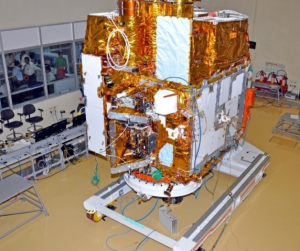Science Seen Physicist and Time One author Colin Gillespie helps you understand your world.
India is Looking for New Views of Strange Objects in the Universe
Good news for India and for science: welcome to a new sophisticated telescope called Astrosat.  The India Space Research Organization (ISRO) designed and built it. Launched a month ago on India’s Polar Satellite Launch Vehicle from the Satish Dhawan Space Centre, it is now in its 400-mile high orbit over the equator. Astrosat has new capabilities that can help us to answer our most fundamental questions.
The India Space Research Organization (ISRO) designed and built it. Launched a month ago on India’s Polar Satellite Launch Vehicle from the Satish Dhawan Space Centre, it is now in its 400-mile high orbit over the equator. Astrosat has new capabilities that can help us to answer our most fundamental questions.
We are living in great times for telescopes. Today’s new space-based telescopes may lead to discoveries as revolutionary as those that followed on Galileo’s small earthbound telescopes five hundred years ago. Why is this investment happening? Is it because these instruments can find new physics at less cost than particle accelerators can? It’s true, they do; but far more fundamentally it is because they can reveal physics at the deepest level—the incredibly tiny Planck scale—which is far beyond the reach of any particle accelerator we can ever build. Roughly speaking, the Planck scale is smaller than an atom like an atom is smaller than our Solar System, only more so. There’s no way we can ever see it. But the universe does things that touch the Planck scale all day every day. It puts on amazing science shows out there for free and (say some, and I am one of them) these shows offer us our best and maybe only windows into physics at a scale where space itself breaks down and is literally particular. Neither relativity nor quantum mechanics has anything to say about the Planck scale.
With the right equipment we can see those amazing shows in many “colors” A broad range of photon frequencies tells tales of physics sent to us by strange cosmic objects. Some are powered by energies we can’t achieve on Earth. Like the human eye, a telescope may show a narrow band of frequencies. But now, with many telescopes in operation, there is a move afoot to study interesting objects using more than one of them. For example, the European Space Organization team that found the first stars forming in the early universe used images from three telescopes to stitch together what they saw. Think of astronomic son et lumiere, or of movies that have not only images but also sound (and now are in 3-D). One gets far more information from two or three senses than from only one.
This is where India’s Astrosat adds a new level of space-telescope sophistication. Like the James Webb Space Telescope (JWST) expected to launch in 2018, it will search for strange events. But Astrosat’s technology gives it a big advantage. As science journalist Pallava Bagla says:
“Instead of focusing on a single region of the spectrum, it carries a suite of five instruments, including two telescopes, which will observe cosmic objects simultaneously in several wavebands: visible, ultraviolet, and soft and hard x-rays.”
These instruments span photon energies from two electron volts to one hundred fifty thousand electron volts. Some of the most interesting objects in the universe, like big black holes in early galaxies, emit photons with energies across this range. So when researchers detect an object giving off a burst of x-rays, using one Astrosat instrument, they can swiftly bring another of its instruments to bear to see what else that object may be telling us. Stay tuned for developments.
One more big ISRO achievement: they built Astrosat for the equivalent of less than $30 million. This is striking because other space telescopes (like JWST) typically cost billions. When cutting-edge physics gets so much less expensive we can do more of it, even as we keep the change.
Sources:
Pallava Bagla (2015), “India to put observatory in orbit: Suite of images will complement other space telescopes”, Science, Washington: AAAS, vol. 349, p. 1271; http://www.sciencemag.org/content/349/6254/1271.full
Image credit: India Space Research Organization, http://phys.org/news/2015-09-india-black-hole-space-satellite.html

No comments yet.